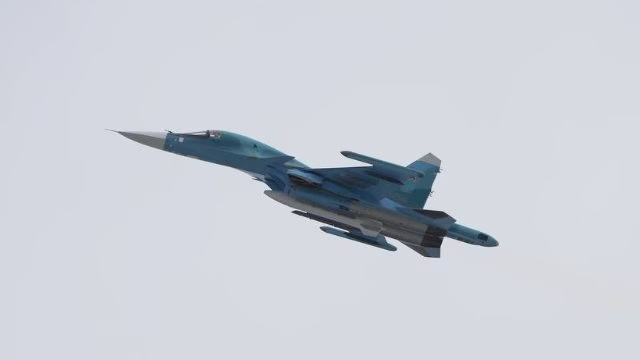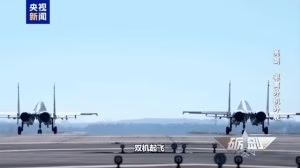Russian Su-34 crash hits Nizhny Novgorod, pilots eject safely


Summary
– A Russian Su-34 jet crashed in Nizhny Novgorod on July 1, 2025.
– Both pilots ejected, but one remains missing.
– The incident raises concerns about Russia’s aging air force.
– Global military tensions could be impacted by this event.
– Details unfold as search efforts continue.
A Russian Su-34 fighter jet crashed Tuesday in the Nizhny Novgorod Oblast, about 250 miles east of Moscow, marking a notable incident for the country’s air force. The crash occurred around 1:42 p.m. local time, with both pilots managing to eject from the aircraft before it struck the ground near the town of Kulebaki.
The Russian Ministry of Defense confirmed the aircraft was an Su-34, correcting earlier reports that identified it as an Su-27, and stated the flight was a scheduled training mission. One pilot has been located and is unharmed, while search teams continue efforts to find the second. The event raises questions about the readiness of Russia’s military aviation amid ongoing global tensions, particularly with the conflict in Ukraine.
Details surrounding the crash remain limited, with no official cause disclosed by the ministry. Local reports suggest the pilots steered the jet away from populated areas, and rescuers are now focused on the forested region southeast of Veletma in the Vyksa district.
There are no confirmed reports of casualties or damage on the ground, though the lack of immediate transparency has prompted speculation about the aircraft’s condition and the mission’s circumstances. As investigations get underway, the focus will likely shift to the Su-34’s maintenance history and the training protocols involved.
What we know so far
The crash site is near the Savasleyka military airfield, a hub for Russian air operations, though it’s unclear if the jet was linked to activities there. The Russian Ministry of Defense’s statement, relayed through state media, clarified the aircraft as an Su-34, a twin-seat fighter-bomber, rather than the initially reported Su-27.
Authorities have not yet released a detailed account, leaving many aspects of the incident unclear. The absence of footage or comprehensive updates has led to reliance on preliminary reports from Russian outlets like Mash and Telegram channels. The crash’s proximity to a military base suggests possible technical or procedural issues, though no evidence supports this at this stage. The ministry’s confirmation of the Su-34 model shifts attention to its specific role and condition.
The Su-34: a modern strike platform
The Su-34, developed in the 1990s and entering service in 2014 after delays, is a twin-seat fighter-bomber designed for precision strikes and long-range missions. Built by Sukhoi, it features a top speed of Mach 1.8, or about 1,400 miles per hour, and a combat radius exceeding 700 miles.
Its sleek, side-by-side cockpit and advanced avionics, including the Leninets B004 radar, allow it to carry a diverse payload—up to 18,000 pounds—of guided bombs, air-to-air missiles like the R-77, and anti-ship weapons. The jet’s ability to deploy guided munitions, such as the KAB-500, makes it a key asset in Russia’s operations.
Unlike the Su-27, which focuses on air superiority, the Su-34 is tailored for ground attack roles, often used in Ukraine to deliver glide bombs. Compared to the U.S. F-15E Strike Eagle, it offers similar multirole capabilities but lacks the latter’s stealth enhancements. Russia’s Su-35, with its thrust-vectoring engines, and the Su-57, a stealth prototype, represent newer advancements, yet the Su-34 remains a backbone of current strike missions.
The pilots behind the controls
Flying an Su-34 demands rigorous training, especially for its dual-role configuration used in training and combat. Russia’s air force employs a structured program, with pilots logging extensive simulator hours before operational flights. The twin-seat design pairs an experienced pilot with a weapons officer or trainee, focusing on strike coordination and emergency procedures, including ejection drills that proved critical here. The ministry’s statement confirms the flight was routine, suggesting a controlled environment.
The ongoing Ukraine conflict has increased demands on pilots, potentially leading to fatigue or oversight. Historical data from Russian aviation indicates human factors play a role in some incidents, though specifics for this case are pending. Pilots on Su-34s typically have years of service, with expertise in bombing runs and survival tactics. Their successful ejections underscore the training’s effectiveness, as noted in general terms by the International Institute for Strategic Studies
A pattern of incidents
Military aviation crashes occur globally, and Russia has seen several recently. A Su-34 crashed in Voronezh Oblast in 2024 due to engine failure, while a Su-30 went down in Rostov during training, both with ejections. These events highlight recurring issues like mechanical wear and maintenance gaps. The U.S. Air Force reported an F-16 crash in Nevada last year due to pilot error, showing a shared challenge across forces. Russia’s fleet, including the Su-34, faces added pressure from sanctions since 2014, limiting access to parts and technology. The crash near Kulebaki fits this pattern, though the ministry’s silence on causes leaves it unconfirmed.
Media and public response
The crash has drawn mixed reactions in Russian media. State channels like Rossiya 1 have aired brief updates following the ministry’s statement, while independent sources like Novaya Gazeta question the lack of detail. Telegram channels report the incident with a blend of concern and routine acceptance, reflecting public familiarity with such events. Social media on X shows curiosity about the missing pilot, with some skepticism toward official accounts.
The absence of footage and limited information on the second pilot suggest a controlled narrative, a tactic seen in past incidents like the 2018 Su-57 crash. Foreign analysts from the Center for Strategic and International Studies have noted Russia’s pattern of information restriction during military setbacks, though no specific comments on this crash are available yet at www.csis.org. The ministry’s clarification to an Su-34 may shape further coverage.
Geopolitical and military implications
The crash occurs as Russia supports its Ukraine campaign, where the Su-34 is heavily deployed for bombing runs. Losing even one jet, even in training, could strain resources, with reports of intense use over eastern Ukraine. The conflict has seen increased drone and missile activity, taxing Russia’s air assets. This incident might prompt a review of operational priorities as the nation pushes for modernization with jets like the Su-57.
Sanctions continue to challenge Russia’s military hardware reliability, a concern heightened by this event. Ukraine, which operates a few Su-34s from Soviet stocks, and India, a Su-30 user, may reassess their reliance on Russian tech.
Tactics and operations under scrutiny
The Su-34’s training mission involved simulating strike scenarios, typically without live ordnance, as inferred from the ministry’s description. These flights test bombing accuracy and emergency responses, relying on sensors like the infrared search and track system. The jet’s design supports Russia’s doctrine of air-ground dominance, crucial in contested zones.
The pilots’ decision to avoid populated areas aligns with safety protocols, but the crash’s cause—technical, environmental, or human—remains under review. Past operations, such as those in Syria in 2015, demonstrated the Su-34’s effectiveness, yet maintenance issues have since surfaced.
Broader technological and strategic trends
Russia’s air force competes with the U.S. F-35 and China’s J-20, which feature stealth and advanced electronics surpassing the Su-34’s capabilities. Sanctions have pushed Russia to seek alternatives, partnering with India on Su-30 variants, though supply issues persist. The crash underscores the difficulty of maintaining a 1990s-era fleet.
Ukraine, having lost Su-34s to Russian strikes, and India may reconsider their strategies. The incident highlights the Su-34’s vulnerability despite its role in modern warfare.
What lies ahead for Russia’s Air Force
With search efforts ongoing, the investigation will likely examine the Su-34’s maintenance and training protocols. The ministry may enhance safety measures or accelerate modernization, though budget limits could hinder progress. The outcome could affect international views of Russia’s military, especially among NATO observers.
Long-term, the crash might push a shift to newer aircraft like the Su-57, despite production delays. Its impact on morale and readiness hinges on the investigation’s openness, a historically rare trait in such cases.
Looking forward: a call for clarity
The Su-34 crash in Nizhny Novgorod Oblast highlights the challenges facing Russia’s air force amid technological and geopolitical pressures. With one pilot safe and another missing, the focus remains on the human story, while broader questions linger about fleet reliability. As details emerge, will the ministry provide the transparency needed to assess this as an isolated event or a systemic issue? The answer awaits.
***
Follow us everywhere and at any time. BulgarianMilitary.com has responsive design and you can open the page from any computer, mobile devices or web browsers. For more up-to-date news, follow our Google News, YouTube, Reddit, LinkedIn, and Twitter pages. Our standards: Manifesto & ethical principles.
How we confirmed this story:
- BulgarianMilitary.com cross-references open-source intelligence, including battlefield maps and geolocated footage, to confirm military movements and resource claims. We analyze official statements, expert insights from defense analysts, and economic data to ensure accuracy.
- Social media posts are scrutinized and validated against primary sources, such as government reports and on-the-ground accounts. Our rigorous process guarantees reliable, fact-based reporting.
















